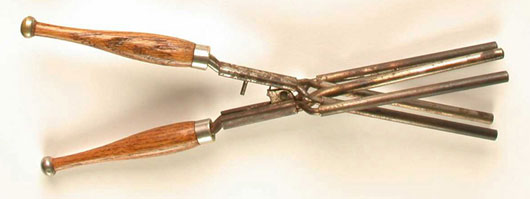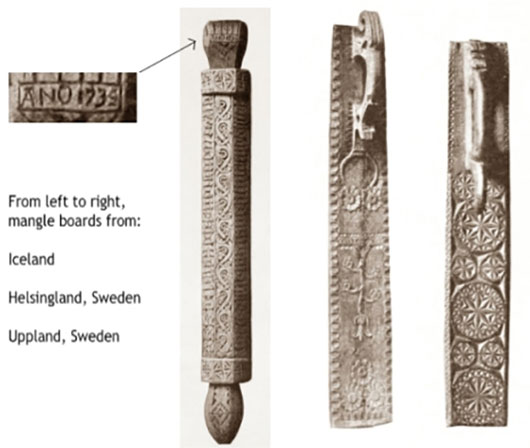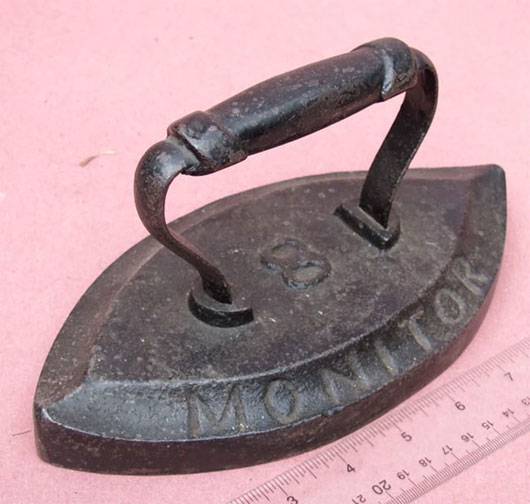History of the iron
Iron (iron) is a very familiar and necessary item for every family. This is a tool to smooth the wrinkles of the fabric to make clothes more neat. Currently, the iron has become an indispensable household item in daily life.
But, have you ever asked the question: How did the ancients do to flatten clothes? How was the iron invented? How does it have a history of development?
"Invite" you back more than 2000 years ago, in ancient Rome to look back at the formation and development of the iron to answer the above questions.
Ancient times - The tools to flatten the early costumes
Thousands of years ago, people had the need to remove wrinkles or create folds on clothing. In ancient Greece (400 BC) ironing was often done by slaves due to the heavy and laborious nature of the work. It was a luxury need of the upper class because only the rich possessed many clothes and slaves. This time, people used iron clips that were heated in the head to create folds on clothes made of linen.

Simulation of clothes flattening tools of Greeks
By the time of Roman Empire, people began to use one - table - rolling - as - by - hand to flatten clothes. It is shaped like a flat metal paddle machine. Wrinkles on clothes are removed by repeatedly hitting the clothes with "rowing machine" . Another tool used to flatten clothes during this period is prelum. This is a tool shaped like a press made of wood. Two pieces of wood are stacked on top of each other and can be tightened with screws made of wood. Clothes were placed in the middle of two wooden boards, then screwed back so that the wooden boards pressed against the clothes, used to create pressure to remove wrinkles.

Rolling tables are used by Romans
Ancient Chinese people also used some iron tools to flatten clothes. The most common tool is an iron pan shaped like a big spoon. People put hot charcoal or hot sand inside the spoon to heat the bottom. Then move the bottom to the clothing surface to flatten.

The iron pan straightens the clothes of the ancient Chinese
Around the 10th century AD, Vikings from Scandinavia soon made glass "iron". They think glass can glide over clothing surfaces faster and make clothes easier to iron than iron. The glass bars are rounded and placed near the heater to heat up, which will then be used to move on the surface of the clothes.

Vikings use a glass tablet to heat the clothes straight
12th to 14th centuries - The first signs of the iron
By the 12th century, when trade between the East and the West began to develop. Fashion began to have an important development with the use of sewing clothes to create more elaborate costumes. People began wearing clothes that had delicate buttons or wavy collar. The need for a type of tool capable of producing temperature and pressure is increasingly urgent.
In the Netherlands in the 1200s, a flat-rolled iron tool was built in the shape of a small boat for ironing clothes. However, due to the limitations of metallurgical techniques, the tools have not been elaborated and sharpened, making it difficult to make high-precision ironing lines. The tool is shaped like the soleplate of an iron today.
100 years later, in the 1300s, taking advantage of metal manufacturing techniques, people could create more sophisticated tools. At that time, popular clothing was a wavy mane collar. In Italy, people started using a tool called Goffering shaped like a steel pipe horizontally on the rack. After heating the iron pipe, they rolled the cloth around the iron pipe to create a wavy drapery collar that was popular during the Renaissance. This is a very time-consuming process, so only the aristocracy can wear that kind of outfit.

Tool to create wavy collar folds of Italians
Then, in order to reduce the time and effort for the wavy folds on the collar, people began to use another tool called Fluter. This is a tool consisting of a base and a part made of iron. At the two contact surfaces are equally spaced vertical grooves. The cloth is placed between the two pieces of iron, and the force of the hand is pressed hard to create equal folds. However, in the process of implementation, people still have to put a piece of cloth in the middle of the contact surface to avoid iron pipes stain on clothes. In addition, another inconvenience is that each Fluter has a specific collar pattern.
Video uses Fluter to create folds
15th to 19th century - The first primitive iron appeared
By the 15th century, thanks to the remarkable progress of metallurgical techniques, people began to have the idea of an empty iron iron that could contain coal inside to heat. This is an empty iron box with a handle, a soleplate made smoothly to easily surf the surface of the clothes while leaving no stains of metal. To heat the soleplate, in addition to embers, one can put them inside: heated bricks, a hot metal rod or other things that can heat and retain heat. It was possible to iron the clothes directly without having to put the cloth underneath the base of the box. This is the pattern of the modern iron used today. The disadvantage of this iron model is that it has not been able to hold heat for long, especially at the tip of the iron. However, the iron sample still continued to be used nearly 400 years later.

The first shape of the iron with removable heating piece
By the time the Bessemer steelworking method was invented in the early 19th century, the outstanding problems of the old basic iron samples were solved. It was possible to make iron-like irons made of steel and heat transfer by putting on a stove. The heat is spread evenly across the base including the position of the iron that allows to smooth out complex positions on clothing such as around buttons, collars, etc. However, the disadvantages of fashion iron It is still not possible to keep heat for long. After a certain amount of ironing, you still have to put on the stove to heat the base. This interrupts the ironing process and is quite eye-time.

Monolithic iron iron
Twentieth Century - The era of innovative inventions and perfection of a modern iron
Until the middle of the 19th century, ironing designs still depended on blacksmiths and consumers' opinions. There have been a number of ironing models available for commercialization, but it has not been able to overcome the downside of waiting for heating time on the stove for too long. In 1871, Mary Florence Potts, an American housewife, received the patent for the removable iron handle. Potts' invention allowed a lot of iron bases to be placed on the stove to heat without waiting. When a base is very hot, users just need to remove the handle and switch to another one that has been preheated. Potts named this generation of iron "Sad Iron" . According to the record, the reason she named "Sad" for the iron was because its weight was too heavy and always made her hands ache when working with it.

"Sad Iron" iron with removable handle
Since the 1800s, gas pipes have appeared in most homes in the United States. In 1874, the idea of making a gas iron was used to heat the base. A gas pipe is connected to the inside of the iron. Gas is then burned to heat the soleplate. However, this method is quickly removed due to the dangerous nature because gas is easily leaked out. Next, to replace the gas, people also heated the iron with other fuels such as gasoline, kerosene, candles and some other fuels.

Iron heating with gas
10 years later, the invention of Mary Florence Potts handle, in the 1880s, electricity began to become popular for every American family. In 1882, the American inventor Henry W. Seeley received a patent for "electric iron". This is the first iron to use electricity to heat the wires attached to the base. This was the first human electric iron and the only household electronic invention in the 60s of the 19th century. However, this electric iron is quite heavy, up to 6kg. The downside of the first iron model is that it cannot control the temperature. By 1920, British inventor Joseph Myers improved the steel wire to transfer the heat inside the iron to a temperature-changing conductor with an automatic controller made from pure silver. The upper thermostat has quickly become the standard of the next generation of iron

Picture of inventor Henry W. Seeley (1861-1943) and the first electric iron
The following years of the 20th century, electric irons were popular and changed the way to flatten the clothes of millions of housewives across the United States. However, the electric iron still could not completely make flat clothes perfectly. Users need another improvement to improve ironing performance to new heights. Not long after, in 1926, architect Thomas Warren Sears (1880 - 1966) released the first steam iron. However, it was not until the 1940s that the first steam irons were officially marketed by Eldec.

Architect Thomas Warren Sears (1880 - 1966).The first to make steam iron
Next, in 1995, the non-stick iron iron was officially introduced. This is a breakthrough in the development of modern iron to this day. Following that was a change in the material of the iron body, people turned to the production of iron-bodied iron to have a lighter weight. Then there is a series of enhancements that make the iron more precise temperature control for a variety of fabric materials and many other value enhancements. As of 1996, there were more than 14 million ironing boards sold with a range of utility features.
Conclusion

Over 2000 years with many important improvements, starting with very rudimentary pieces of Roman metal, to Viking glass, accompanied by the development of fashion and transparent metallurgy techniques in the Renaissance, to invent a simple housewife's hand, then a series of important improvements, the product was finally an iron that was so familiar to every family everywhere. gender. We are somewhat aware of things that are too ordinary but have a long history of formation and development. Hopefully, through the article, you can somewhat better understand the things around your home so that the laundry can be "more fun" .
- Ancient people made iron from meteorites
- Found traces of new forms of iron from the Antarctic universe
- Top 10 iron-rich foods
- How do bacteria get iron from humans?
- Miraculous fish fever in Cambodia
- With today's science and technology, is Iron Man's armor possible?
- Production of rice with added iron
- Iron fish cure anemia for Cambodians
- Mysterious iron pillar of 1,600 years old stainless steel
- France proceeded to excavate the site from the Iron Age
- Discovered 1,000-year-old iron arrow in the mountains
- Iron makes feminine
 'Fine laughs' - Scary and painful torture in ancient times
'Fine laughs' - Scary and painful torture in ancient times The sequence of numbers 142857 of the Egyptian pyramids is known as the strangest number in the world - Why?
The sequence of numbers 142857 of the Egyptian pyramids is known as the strangest number in the world - Why? What is alum?
What is alum? Miracle behind the world's largest stone Buddha statue
Miracle behind the world's largest stone Buddha statue